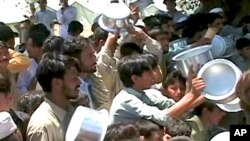A proposal being considered by India’s political leaders would change the way the nation’s poor receive government aid. Some politicians and government economic advisers are proposing scrapping the current system and instead distributing food coupons directly to the poor.
Currently, poor Indians receive a special card with which they can purchase food at “fair price shops” set up to distribute food to the needy. The food is procured and sold through the government’s Public Distribution System (PDS).
A coupon system would eventually enable poor people to purchase food in any store in the country, not just those in the government system.
“By introducing the direct subsidy system, the government can spend half the money it is spending now and get double the benefit,” economic advisor Kaushik Basu told the Economic Times.
The current system is expensive to operate in part because resources moving through the system have a tendency to “leak out” through theft and inefficiency.
“The trucks sometimes don’t reach (or only half the load reaches) the shop, sometimes there is a lot of siphoning of the grain that takes place even at the fair price shops,” said A. Ganesh-Kumar, a New Delhi-based research fellow with the International Food Policy Research Institute.
Besides leakage, he says one the most important of India’s challenges is to determine exactly how many poor people there really are.
“The coupon system is an alternative in the sense that the government does not get itself involved in the actual business of procuring, storing and distributing grains,” Ganesh-Kumar said. “It can bring down costs for the government, but the same issue of the identification of the poor remains,” he added.
“To be effective, a coupon system needs a complete registry of all the citizens of the country,” he pointed out. “Right now the government has set up a unique identity authority which is supposed to do exactly that, but this process will take maybe two or three years…” he said.
Ganesh-Kumar says poverty estimates widely range between 28 to 80 percent of the population, but the official government figure is 37 percent. He says some people currently receiving benefits are not really poor and some who do need help are not getting it.
With the need so great, feeding the poor has been a perennial issue in political campaigns in India and leaders routinely promise to eliminate hunger.But many poor people are simply “falling through the cracks” in the current system.
Despite a generous allocation of government resources, many poor people continue to suffer from malnutrition.
The British newspaper the Guardian reported this year that there are more poor people in India than in all of the 26 nations of sub-Sahara Africa combined. The Times of India reports that half of all child deaths in India are due to malnutrition.
A. Ganesh-Kumar said he regretted that the cost-effectiveness of the current system has not been given enough attention in current discussions about possible changes. “The need of being cost effective is…not even being debated in this country,” he said.”
Ganesh-Kumar would not hazard a guess as to whether the new coupon system will be approved. He pointed out that there are more than 100,000 people who work for the current system and they will undoubtedly oppose getting rid of it.







